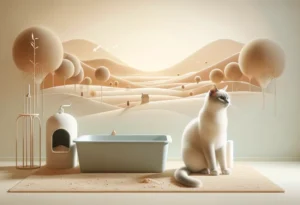Cats are known for giving birth to multiple kittens at a time, leaving many wondering why this is the case. While it may seem like a lot to handle for a single momma cat, there are actually some fascinating reasons behind why cats have litters of kittens.
Cats give birth to multiple kittens as a survival strategy.
Evolutionary Advantage
Cats’ ability to give birth to multiple kittens at once is not just a random occurrence – it actually serves as a key evolutionary advantage for the species. In the wild, having multiple offspring in a single litter increases the chances of survival for at least some of the kittens. This strategy helps ensure that the cat population can thrive even in challenging environments where resources may be limited.
One fascinating aspect of this evolutionary advantage is that cats are able to adjust the size of their litters based on environmental factors. For example, if a cat senses that food sources are abundant, she may have a larger litter. Conversely, if resources are scarce, she may have a smaller litter to ensure the survival of the kittens.
Additionally, a larger litter size can also help to deter potential predators. By having multiple kittens at once, a mother cat can better defend her offspring and increase the chances of at least some of them reaching adulthood. This evolutionary strategy has been honed over generations, leading to the efficient reproduction cycle we see in cats today.
For further insight into the evolutionary advantages of cats giving birth to multiple kittens, you can refer to this resource from the National Geographic Society: National Geographic – The Evolution of Cats.
Reproductive Cycle
One of the main reasons why cats give birth to multiple kittens in a single litter lies in their unique reproductive cycle. Unlike humans, who have monthly cycles, cats have an induced ovulation cycle. This means that a female cat only releases eggs for fertilization when she mates with a male.
During mating, a male cat’s barbed penis stimulates the female cat’s reproductive tract, triggering the release of eggs for fertilization. This process often results in multiple eggs being fertilized, leading to a litter of kittens with different fathers.
Another interesting aspect of the feline reproductive cycle is that a cat’s heat period can last anywhere from a few days to a few weeks. This variability allows female cats to mate with multiple males during a single heat cycle, further increasing the chances of multiple fertilizations and the birth of a litter of kittens.
Overall, the unique reproductive cycle of cats, combined with their evolutionary advantages, has led to the fascinating phenomenon of multiple kitten births in the feline world.
Resource Availability
When it comes to understanding why cats give birth to multiple kittens, one key factor to consider is resource availability. Cats, being natural hunters and solitary animals, have evolved to produce larger litters when resources are abundant. In the wild, a higher availability of food and shelter can signal to a cat that it is a good time to have more offspring. This instinctual response ensures the survival of the species in times of plenty.
Additionally, stress and competition for resources can also play a role in determining litter size. A cat may give birth to more kittens if she senses that resources such as food or nesting spots are limited. This adaptive behavior increases the chances of some kittens surviving to adulthood in a challenging environment.
Overall, resource availability is a crucial factor that can influence the number of kittens a cat gives birth to at one time. Understanding this aspect of feline reproduction can provide valuable insights into the natural behavior of cats and help cat owners better care for their pets.
Genetic Factors
Genetics also play a significant role in determining the size of a cat’s litter. Inherited traits can predispose a cat to giving birth to a specific number of kittens. Some cat breeds are known to have larger litters, while others may typically have smaller ones.
Reproductive health is another important genetic factor to consider. Cats with optimal reproductive health are more likely to have larger litters, as they are better equipped to conceive and carry multiple kittens to term. Genetic conditions that affect fertility or the ability to carry a pregnancy to full term can influence litter size as well.
By understanding the genetic factors at play in feline reproduction, cat owners and breeders can make informed decisions regarding breeding practices, health care, and overall well-being of their cats.
Helpful resource: For more information on the genetics of cat litter size, check out this article by the American Society for the Prevention of Cruelty to Animals (ASPCA): Genetics of Feline Reproduction.
Remember that both resource availability and genetic factors interact to determine the number of kittens a cat gives birth to, showcasing the intricate balance between nature and nurture in feline reproduction.
Hormonal Influences
When it comes to the number of kittens a cat gives birth to, hormonal influences play a crucial role. Female cats experience a surge in hormones during their heat cycles, leading to the release of multiple eggs. This biological mechanism increases the likelihood of fertilization by different male cats, ensuring genetic diversity in the litter. Moreover, these hormonal changes can result in the development of multiple embryos, ultimately leading to a larger litter size.
Maternal Care
Mother cats play a vital role in caring for their litters, providing warmth, protection, and nourishment. Having multiple kittens is beneficial for socialization and learning. Through interactions with their siblings, kittens learn crucial skills such as hunting, grooming, and communication. Additionally, larger litters can stimulate maternal instincts in the mother cat, enhancing her caregiving abilities and ensuring the survival of the entire litter.
Additional Unique Insight:
In addition to socialization benefits, having multiple kittens in a litter can also help in regulating the body temperature of the newborns. As kittens huddle together for warmth, especially in the early days of their lives, larger litters can provide better insulation and help maintain their body heat more effectively.
Remember, understanding the underlying hormonal influences and the importance of maternal care can shed light on why cats give birth to multiple kittens. By considering these factors, you can appreciate the biological complexities behind feline reproduction and the significance of larger litters for the well-being of both mother and kittens.
Human Intervention
Have you ever wondered why some cats give birth to more kittens than others? Well, it turns out that human intervention plays a significant role in controlling the size of a cat’s litter. Spaying and neutering are common practices that help regulate the population of kittens that a cat can have. Spaying refers to the surgical procedure done on female cats to prevent them from getting pregnant, while neutering is the equivalent for male cats. These procedures not only help reduce the number of unwanted kittens but also have health benefits for the cats themselves. So, next time you see a cat with a large litter, remember that human actions can influence the size of that furry family.
Fun Facts About Cat Litters
Let’s dive into some fun and intriguing facts about cat litters that will leave you amazed. Did you know that the largest recorded litter of kittens is 19? Yes, you heard that right – 19 adorable felines from one proud mama cat! Another interesting fact is that a cat’s first litter is usually smaller than subsequent ones. It’s like they’re just warming up before going full throttle with the kitten production. And here’s a unique twist – cats can actually mate with multiple partners, leading to litters with kittens from different fathers. So, the next time you see a litter of kittens, remember that there’s more to it than meets the eye.
Additional Unique Insight:
When it comes to cat litters, breed can also play a significant role in how many kittens a cat gives birth to. Certain breeds are known to have larger litters than others, so genetics can contribute to the number of kittens in a litter. This adds another layer of complexity to why some cats have more kittens than others. So, if you ever find yourself surrounded by a bunch of fluffy little kittens, remember that their breed may have had a paw in their abundance.
Alex, a passionate animal lover, has experience in training and understanding animal behavior. As a proud pet parent to two dogs and three cats, he founded AnimalReport.net to share insights from animal experts and expand his knowledge of the animal kingdom.




